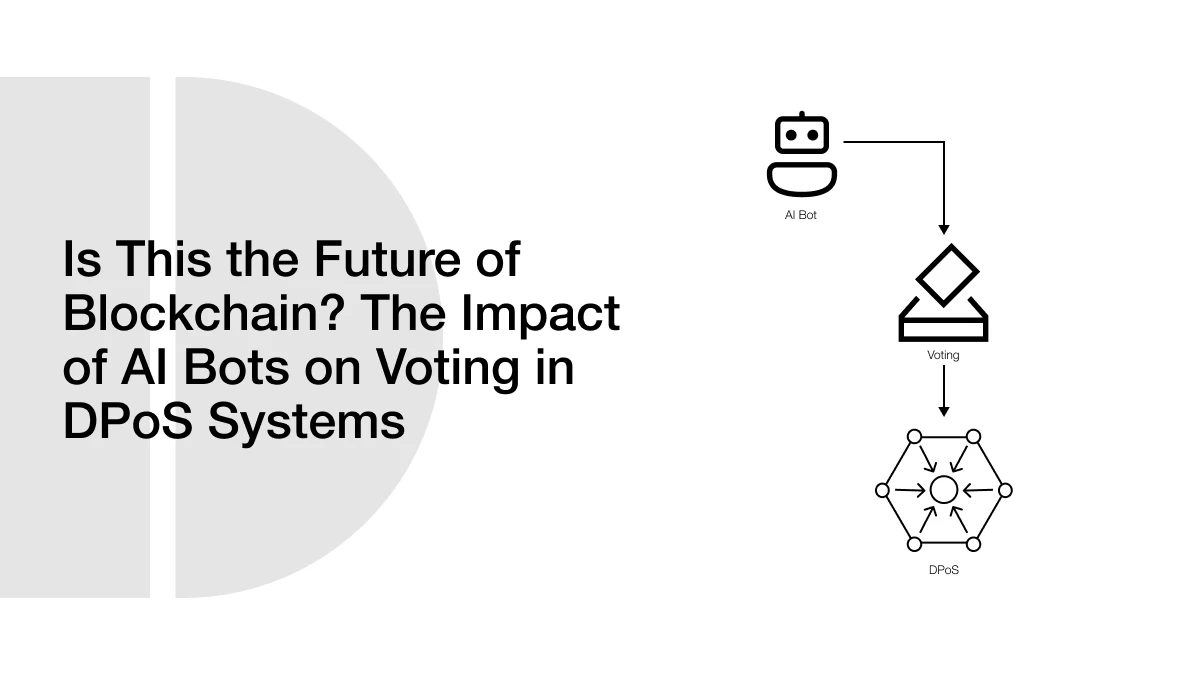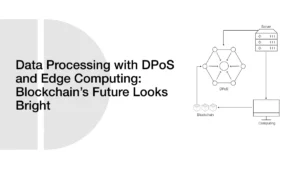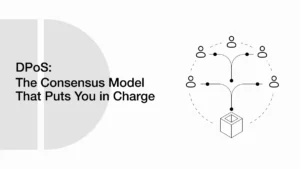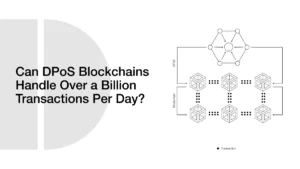Is This the Future of Blockchain? The Impact of AI Bots on Voting in DPoS Systems

Blockchain has changed how people think about trust, voting, and digital ownership. One of the systems that helps run these blockchain networks is called Delegated Proof of Stake, or DPoS. This system lets users vote for trusted members, called witnesses or delegates, to manage the network on their behalf. Now, imagine if it weren’t people casting these votes anymore. What if AI bots started voting instead?
- Understanding DPoS Voting
- What Is Delegated Proof of Stake (DPoS)?
- How Do People Vote in DPoS?
- What Happens After You Vote?
- Why Do People Vote?
- What Are AI Bots and How Could They Vote?
- What Is an AI Bot?
- How Can AI Bots Vote in DPoS?
- Are Bots Already Doing This?
- The Benefits of AI Voting in DPoS
- 1. Faster and Smarter Voting Decisions
- 2. No Voting Decay
- 3. Better Monitoring and Reporting
- 4. More Informed Voting
- The Risks of Letting AI Bots Vote
- 1. Centralization and Sybil Attacks
- 2. Who Controls the Bot?
- 3. Delegation Cartels
- 4. Hackability and Exploits
- How AI Voting Could Change Network Power
- AI Could Make Voting Less Human
- Full Vote vs. Split Vote: What Happens with Bots?
- What If Bots Only Vote for Big Names?
- Real Examples and Hypothetical Scenarios
- EOS: From Humans to Bots?
- TRON: AI Bots and 24-Hour Elections
- Hypothetical: AI Bot War on BitShares
- Lessons from These Examples
- Possible Solutions and Safeguards
- Will AI Voting Be the Future of DPoS Governance?
- Conclusion
- Frequently Asked Questions (FAQs)
- Glossary of Key Terms
AI, or artificial intelligence, is already doing many tasks in finance and crypto, like trading, scanning news, and detecting fraud. But soon, these bots might become part of blockchain governance. They could start making decisions that shape how networks grow and operate. This blog explores what happens if AI bots start voting in DPoS systems. Is it a good thing? Could it break the system? Or could it actually make blockchains better and faster? Let’s start with the basics.
Understanding DPoS Voting
What Is Delegated Proof of Stake (DPoS)?
DPoS is a system used in some blockchains to keep everything fair and secure. Instead of everyone helping to verify transactions (like in Bitcoin), users vote for a small group of trusted people or computers. These trusted members are called delegates or witnesses.
These elected members do the heavy work: they check transactions, add them to the blockchain, and earn rewards. The more votes a person or group gets, the more likely they are to be chosen.
How Do People Vote in DPoS?
To vote, a person needs to lock up some of their coins or tokens. This is called staking. Once their tokens are staked, they can pick one or more delegates or witnesses they trust.
Voting in DPoS can happen in two main ways:
| Voting Type | How It Works |
| Split Voting | You divide your tokens among different delegates. |
| Full Voting | Each delegate you vote for gets your full vote power. |
Let’s say you have 100 tokens:
- In split voting, you might give 30 tokens to Alice, 40 to Bob, and 30 to Carol.
- In full voting, all three might get the full power of your 100 tokens.
Some blockchains let you vote for multiple delegates at once. Others limit you to just one.
What Happens After You Vote?
Once votes are counted, the top delegates become active witnesses. These witnesses help keep the network running by validating new blocks. If a witness does a bad job, voters can remove them by simply switching their votes. This keeps the system fair and flexible.
ALSO READ: How DPoS Builds Trust in Tokenized Real Estate, Art, and Gold
Why Do People Vote?
People vote to help choose who keeps the blockchain safe. But there’s also a financial reason. Voters often receive a part of the rewards that the witness earns for validating blocks. So, good voting can mean better rewards.
What Are AI Bots and How Could They Vote?
What Is an AI Bot?
An AI bot is a computer program that can make decisions on its own. It can learn from data, adapt to new situations, and act without a human pressing buttons. AI bots are already being used in many areas, including:
- Customer service (chatbots)
- Crypto trading (trading bots)
- Fraud detection (security bots)
- Market research (news scanners)
Now, some people are thinking about letting these bots vote in blockchain governance systems, like DPoS.
How Can AI Bots Vote in DPoS?
An AI bot would need to hold or control tokens to vote. It could be linked to a wallet and follow a set of instructions or algorithms. These bots could analyze large amounts of data to choose the best delegates based on speed, honesty, rewards, or any other factor.
Bots could be programmed to:
- Stake tokens at the right time
- Vote for high-performing witnesses
- Change votes quickly if someone becomes unreliable
- Maximize rewards for their owner
In short, the bot would act like a very focused, very fast voter that never forgets and never sleeps.
Are Bots Already Doing This?
Not yet, not in a full way. But smart contracts and governance bots are starting to take part in simpler votes, especially in DAO (Decentralized Autonomous Organization) systems. In the future, these bots could be updated to handle complex DPoS voting tasks.
Below is a table to show how a regular voter compares to an AI bot in DPoS:
| Feature | Human Voter | AI Bot Voter |
| Speed | Slow | Very fast |
| Decision-making | Emotional or random | Data-driven |
| Availability | Limited (time, interest) | 24/7 nonstop |
| Consistency | Can forget or stop voting | Always follows rules |
| Risk of Hacking | Moderate (phishing etc.) | High if code is insecure |
The Benefits of AI Voting in DPoS
Let’s explore the good side first. AI bots can bring some exciting improvements to how voting works in DPoS networks. Here are the main reasons why.
1. Faster and Smarter Voting Decisions
Humans need time to research, think, and act. AI bots do not. They can scan data across the blockchain, check performance records of witnesses, compare vote histories, and vote within seconds. This could make governance more responsive and accurate.
ALSO READ: Privacy in DPoS: Why It Needs Zero-Knowledge Proofs (ZKPs) More Than Ever Now
For example, if a witness suddenly fails to produce blocks or acts dishonestly, an AI bot can detect it and change votes immediately, unlike human voters who might wait days or weeks.
2. No Voting Decay
In DPoS, votes lose their strength over time if not refreshed. This is called voting decay. It’s meant to prevent users from forgetting about old ballots. But AI bots never forget. They can refresh votes regularly and automatically, keeping their vote strength at full power.
This reduces the number of “dead votes” that keep bad witnesses in power due to voter inactivity.
3. Better Monitoring and Reporting
AI bots can track metrics like:
- Block production success rate
- Uptime and reliability of witnesses
- Reward distribution history
- Past governance behavior (votes for or against proposals)
With this data, bots can vote based on performance, not popularity. This makes the system more merit-based and less political.
4. More Informed Voting
Most human voters don’t have time to study every witness or proposal deeply. Bots can analyze vast amounts of information and make decisions based on that data. This can lead to better choices and stronger security for the network.
The Risks of Letting AI Bots Vote
AI bots offer great benefits, but they also come with real dangers. If not handled carefully, they could damage the DPoS system they’re trying to improve.
1. Centralization and Sybil Attacks
One of the biggest risks is centralization. If a single person controls many AI bots, they could control the outcome of votes. This could lead to a Sybil attack, where many fake identities are used to influence a system unfairly.
In DPoS, this means a single person could run multiple bots, each with a small amount of staked tokens. If left unchecked, they could vote in their own delegates and gain too much power.
| Scenario | Outcome |
| One person runs 1 AI bot | Limited impact |
| One person runs 100 bots | Can control elections (Sybil risk) |
| Bots spread across users | Balanced voting |
2. Who Controls the Bot?
AI bots are just tools. Someone programs them. That means the real power still belongs to the person behind the bot. The AI will vote exactly as instructed.
So the question becomes: who sets the voting rules? Is the bot voting for network health, or just for profit? This creates a problem of transparency and accountability.
If a bot always picks witnesses that give high rewards but ignore protocol rules, the network could become unstable.
3. Delegation Cartels
Some bots might be programmed to always vote for the most popular witnesses. Over time, this could lead to cartels, small groups of powerful witnesses who keep voting for each other using their bot armies.
This could reduce competition and deter new candidates. It also makes the system easier to corrupt. Bots might also sell their vote to the highest bidder, making DPoS more about money than trust.
4. Hackability and Exploits
AI bots rely on code and data. If their code has a bug, or worse, if it gets hacked, a bad actor could take control of the bot’s wallet, change votes, or even redirect staked funds.
ALSO READ: How Regulatory Compliance in DPoS Dawns a New Era in Blockchain Governance
Security becomes critical. And since many bots use smart contracts or APIs to interact with the blockchain, every connection point becomes a potential weakness.
How AI Voting Could Change Network Power
AI bots won’t just vote faster; they could shift how power works in a Delegated Proof of Stake (DPoS) system. If bots vote differently from humans, the balance of influence could change dramatically.
AI Could Make Voting Less Human
When people vote, they often think about fairness, trust, and personal values. AI bots don’t feel emotions. They make decisions based on math, logic, and code. This can lead to cold, calculated voting behavior.
If AI bots are told to vote only for witnesses who give the highest rewards, the system becomes focused on profit, not community trust. Bots could ignore long-term health and focus only on short-term gains.
This might sound efficient, but it’s risky. DPoS networks are not just machines. They’re social systems that rely on fairness and cooperation. If bots push out smaller or newer witnesses, the system could become too rigid or unfair.
Full Vote vs. Split Vote: What Happens with Bots?
Bots can vote in different ways, depending on the network’s configuration.
In split vote schemes, tokens are divided among several candidates. This system can protect against one group taking total control.
But in full vote schemes, a bot can give its full voting power to multiple delegates simultaneously. This can lead to dangerous outcomes.
Let’s look at a table to show how bots behave in these two systems:
| Voting Type | AI Bot Behavior | Impact |
| Split Vote | Divides the stake among many candidates | More balanced, but slower change |
| Full Vote | Gives full power to all favorites at once | Can lead to total control by one group |
If one person programs 100 bots under a full vote scheme, they could easily push their preferred witnesses to the top, especially if other voters are inactive.
What If Bots Only Vote for Big Names?
Another problem: bots often follow the data. And data usually shows that popular witnesses perform well. So bots might always vote for the “top 10” delegates, never giving new or smaller voices a chance.
This could lead to a cycle:
- Bots vote for big names
- Big names stay in power
- Smaller delegates never get attention
- Voter choice slowly disappears
In the end, the system could become centralized, which is the opposite of what blockchain stands for.
Real Examples and Hypothetical Scenarios
Now let’s make this real. How could AI bots affect networks like EOS, TRON, or BitShares? What might happen if bots begin to dominate voting?
EOS: From Humans to Bots?
EOS is a major DPoS network with 21 active block producers (delegates). Today, humans vote for these producers using staked EOS tokens.
Now, imagine a future where 50% of all voters are AI bots. These bots analyze performance, uptime, and reward rates every hour. If a block producer misses a block or underpays rewards, bots instantly remove their votes.
The upside? High accountability and fast reaction.
The downside? Short-term thinking. Bots may favor producers who offer big rewards today but don’t plan for the long term.
Also, if one company controls most bots, it could gain major influence over block production.
TRON: AI Bots and 24-Hour Elections
TRON holds witness elections every 24 hours. In theory, this is perfect for bots. They can vote daily, update their picks, and maximize rewards every cycle. Let’s say a developer creates a bot called “TronVoteX.” It’s open-source and promises to vote only for witnesses with perfect uptime and generous payouts.
Within weeks, 20,000 users install the bot. Now, TronVoteX controls over 60% of the votes.
- Is that decentralized?
- Who really holds the power, the users or the bot creator?
- What if TronVoteX is later updated to vote only for witnesses from one company?
This shows how a single AI system can reshape governance, even in a system designed for fairness.
Hypothetical: AI Bot War on BitShares
In BitShares, up to 101 witnesses are active. Now picture two rival AI developers launching competing bot systems:
- “BitBot Alpha” is designed to vote for witnesses with the highest uptime.
- “BitBot Beta” votes for witnesses who promise the highest rewards.
Within days, both bots start dominating the elections. Delegates begin changing their strategies; some boost uptime, others offer bigger payouts. Soon, the top 30 witnesses are selected entirely by bots.
- Human voters stop participating.
- Smaller candidates disappear.
- Bots begin voting for their own group of witnesses.
Lessons from These Examples
From EOS to TRON to BitShares, the message is clear:
AI bots can improve speed and accuracy, but they can also cause power imbalances if used carelessly.
If AI systems take over too much of the voting process, DPoS networks risk becoming too automated, too centralized, and too controlled by the people who write the bots.
Possible Solutions and Safeguards
AI bots voting in DPoS networks may be useful, but there must be strong rules to ensure fairness. Without safety checks, bots could take over and ruin the system. Developers, users, and network leaders must anticipate potential threats and build tools that prevent abuse. One way to reduce bot control is to use vote decay more strictly. In systems like EOS, vote decay lowers a vote’s power over time. If bots are forced to refresh votes more often, they must prove they are still acting in the best interest of the network. This also gives human voters a chance to keep up, especially if they return after some time away.
Another way to keep bots in check is to verify their identity. This could include linking a bot wallet to a human or requiring proof-of-personhood before allowing votes. That way, only real users or verified bots can influence the system. If this is done right, it stops one person from running hundreds of fake bots under different names. Some networks may decide to limit the number of votes a single wallet or address can cast. This stops large players from gaining too much power. It also encourages a broader spread of votes, which keeps things fairer for smaller candidates. If bots must follow limits, they can’t easily flood the system.
Smart contracts can also help. Bots that vote through smart contracts can be programmed with public logic. This means other people can check the rules they follow. If a bot claims to vote for fairness and long-term growth, users can verify that claim by looking at its code. This creates transparency and trust. A better system might mix AI and human input. For example, bots can collect data, but people can make the final voting decision. Or bots can suggest witnesses to vote for, and users approve or reject those choices. This kind of hybrid system uses the best of both worlds.
In the end, safeguards must protect the voting system while keeping it flexible. If AI bots are allowed to vote without limits, the risk of unfair elections becomes too high. But if done right, bots can become tools that help people vote smarter, not tools that take voting away from them.
Will AI Voting Be the Future of DPoS Governance?
AI is becoming part of everything. From trading to customer service, it’s already helping people make faster and better choices. It makes sense to ask if AI voting could become normal in blockchain too, especially in DPoS networks where voting happens often and matters a lot. AI bots are fast. They can track thousands of records, analyze trends, and make instant decisions. These are things most humans can’t do without tools. Bots also never forget. They don’t lose interest, get bored, or ignore their voting power. In that way, AI bots seem like a natural upgrade to current voting systems.
But voting is not just about speed and data. It’s about values, fairness, and trust. Bots don’t feel trust. They don’t think about fairness unless someone programs them to. That means bots reflect the person who created them. If that person wants profit, the bot will vote for high-paying witnesses. If they wish to control, the bot will vote for witnesses they can influence.
Bots are not neutral; they follow instructions. That brings up a big question. Can we build bots that care about the network, not just rewards? It’s possible, but it’s not guaranteed. For AI voting to work well in DPoS, there needs to be shared rules, open design, and strong checks. Otherwise, the same power that makes bots worthwhile will make them dangerous.
Some blockchain experts believe AI is the next step. They say that AI voters can remove bias, vote 24/7, and make more informed decisions than people. Others are more careful. They worry that bots will lead to central control, fewer human voices, and lower trust in the system. In truth, the future may be a mix. AI bots will likely become part of DPoS governance, but not the only part. Human voters may still play a big role, especially in choosing how bots are used. Developers may build tools that let people use bots without giving up control.
What happens next depends on how the blockchain community decides to act. If people plan and build the right tools, AI bots can become helpful partners. If they rush into it without limits, bots may become the new rulers of a system meant to be fair and shared.
Conclusion
The idea of AI bots voting in Delegated Proof of Stake (DPoS) networks is no longer science fiction. It’s becoming a real possibility. AI bots can vote faster, refresh more often, and track data better than any human. They don’t forget, don’t get tired, and don’t make emotional choices. On the surface, this sounds like an upgrade for blockchain voting systems. But there’s a hidden risk. AI bots follow code. People write that code. If the person’s goal is profit or control, the bot will vote that way. If many bots are controlled by one person or company, the system becomes unfair. It becomes a race to the top for whoever owns the most bots.
DPoS systems are built on trust, fairness, and community input. That’s why it’s so important to add clear rules and limits before letting bots take over voting. With good design, transparency, and some human checks, AI bots can help make voting smarter. Without these safeguards, bots could break the very system they are supposed to support. AI is coming to DPoS. The big question is: will we guide it, or let it guide us?
Frequently Asked Questions (FAQs)
- Can AI bots vote in DPoS blockchains?
Although not officially in most networks, with access to wallets and APIs, bots can be programmed to vote like humans in DPoS blockchains.
- What risks come with AI voting in blockchain?
The biggest risks are centralization, voting manipulation, and reduced fairness if a few powerful users control bots.
- How is voting done in DPoS systems?
Users stake their tokens and vote for trusted witnesses or delegates who help run the DPoS network. Voting can be split or full.
- What is vote decay, and how does it affect bots?
Vote decay means your vote loses strength over time. Bots can refresh votes automatically, which gives them more power than inactive human voters.
- Are there ways to stop bots from taking over?
Yes. Vote limits, identity checks, public smart contracts, and hybrid AI-human voting models can help control bot power.
Glossary of Key Terms
Delegated Proof of Stake (DPoS)
DPoS is a blockchain system where users vote for delegates or witnesses who run the network.
AI Bot
A program that makes decisions automatically using artificial intelligence.
Witnesses
Elected block producers who validate transactions and create new blocks in DPoS.
Vote Decay
A system where a vote loses power over time unless refreshed.
Sybil Attack
A type of attack where one person uses many fake identities to gain unfair control in a system.
Full Vote Scheme
A voting method where all selected candidates receive the full power of a voter’s stake.
Split Vote Scheme
A voting method where a voter divides their stake across multiple candidates.
Smart Contract
A self-executing program stored on a blockchain that follows set rules automatically.
Cartel
A group of delegates or witnesses who work together to control votes and stay in power.
Proof-of-Personhood
A method to verify that a user is a real human being, not a bot or fake identity.




